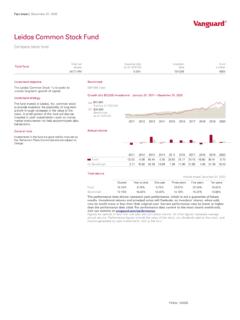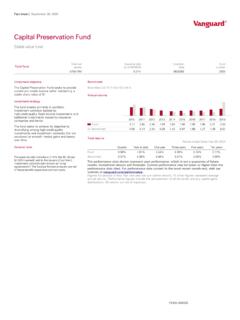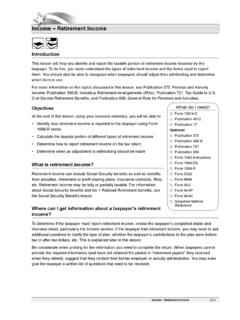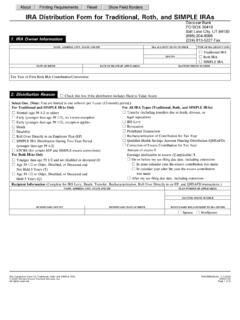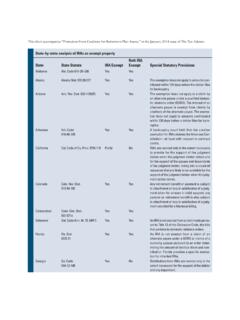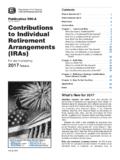Transcription of Differences between a Roth in-plan conversion and a Roth ...
1 Differences between a Roth in-plan conversion and a roth ira rollover Roth in-plan conversionRetirement plan to roth ira conversionPassed into law The Small Business Jobs Act of 2010 (SBJA) signed into law on September 27, 2010. Modified by The American Taxpayer Relief Act of 2012 (ATRA), signed into law on January 2, Tax Increase Prevention Reconciliation Act of 2005 and the Pension Protection Act of 2006 (PPA). Effective dateSeptember 27, 2010, as part of the SBJA. January 2, 2013, as modified by ATRA. This is an optional provision that plan sponsors may add to their plans. Under PPA, direct rollovers from qualified plans to Roth iras were permitted beginning January 1, 2008, but subject to limitations based on taxpayers adjusted gross incomes (AGI).
2 Effective January 1, 2010, the $100,000 household AGI limit was of taxation* You must pay taxes on any pre-tax money that you convert to Roth. The taxable portion of the distribution must be included in gross income in the year of conversion . Same. Tax implications of converting The variety and complexity of individual circumstances suggest that you should consult a tax advisor before deciding whether to convert to Roth. You must consider potential state and local tax implications, as well as quarterly estimated taxes, before converting. See Year of taxation above. Same. Early withdrawal penalty tax Converted amounts that are withdrawn within five years of the conversion are subject to a 10% federal penalty tax for participants who have not yet reached age 59.
3 A new five-year holding period will apply for each Roth conversion for purposes of this 10% federal penalty tax, regardless of whether you have previously made Roth plan contributions. Same. Qualified withdrawal from a Roth accountA withdrawal is generally qualified (that is, tax-free) if the Roth source has been established for at least five years and you are at least age 59 at the time of the withdrawal. A withdrawal is generally qualified if the roth ira (or any other roth ira owned by the investor) has been established for at least five years and you are at least age 59 . It will also be considered qualified if you are under age 59 and owned a roth ira for at least five years, and the distribution is because of death or disability or is for the purchase of a first home ($10,000 lifetime maximum).
4 Recharacterization reverse or undo a conversionA recharacterization of a Roth in-plan conversion is not available for conversionFor you to be able to convert traditional qualified plan money (pre-tax or after-tax) to Roth within the plan , your plan must offer Roth contributions. All or a portion of the savings within your retirement plan account, distributable or otherwise, can be converted in-plan to a Roth account within the plan . To be eligible to convert traditional qualified plan money to a roth ira , you must otherwise have access to that money. Generally, this means you must either be eligible for an in-service withdrawal or have a distributable event under the plan s rules.
5 conversion of after-tax moneyIn general, if a participant converts after-tax assets to Roth, he or she would owe taxes on the portion of the conversion that represents earnings on those after-tax assets. who may find a conversion beneficial A Roth conversion could generally be considered beneficial if you: Expect your tax rate to be the same or higher in the future. Are interested in tax diversification. Can pay the conversion taxes out of non-retirement money. plan to keep the money invested for the long term. These are general guidelines. You should work with a tax advisor in deciding whether a conversion is right for you.
6 Same. conversion is generally not recommended for: A Roth conversion will generally be less beneficial if you: Must withdraw retirement savings to pay conversion taxes. Need access to the money within five years and before turning age 59 . Expect a lower tax rate in retirement. These are general guidelines. You should work with a tax advisor in deciding whether a conversion is right for making this decision, consider: Investment options and related investment expenses that apply if the money remains in the plan . Fees. The potential for stronger protection from creditors.
7 Ta xes. Control and flexibility. Consolidation. Requirement to receive Required Minimum Distributions. Investment options and related investment expenses if the money is transferred to a roth ira . Fees. Ta xes. Control and flexibility. Consolidation. Exclusion from Required Minimum Distribution rules. More favorable basis recovery rules. Required Minimum Distributions (RMDs)Roth plan accounts are subject to RMDs. These rules require that after age 72, in accordance with current laws, you must receive minimum amounts from the Roth plan account each year.
8 Roth iras are not subject to RMD rules during the IRA owner s lifetime. roth ira assets can continue to grow tax-free until the roth ira owner s death; however, beneficiaries are subject to RMDs after the owner s recovery rules for amounts distributed from Roth accounts Nonqualified distributions from a designated Roth account in an employer sponsored plan must be made on a pro-rata basis. Therefore, a nonqualified distribution would include an earnings portion, which would be from Roth iras are treated as being made in the following order: contributions, conversions (on a first-in-first-out basis), then earnings.
9 Accordingly, if an individual takes a partial distribution from a roth ira and does not meet the requirements for a qualified distribution ( , generally, distributions made after five years and attainment of age 59 , death, or disability), the Roth basis (contribution and conversion amounts) is recovered before any taxable earnings must be distributed. Participant loansYou may be able to borrow the money you convert to Roth within your retirement plan . Consult your plan s rules for specifics regarding availability, amount, and timing of are not available from Roth homebuyer expensesFirst-time homebuyer expenses do not count as a qualified distribution from a Roth plan account in an employer-sponsored plan .
10 A qualified distribution from a roth ira also includes distributions made after five years to cover a first-time homebuyer s expenses up to $10,000.*Please consult your tax advisor. Note: This chart is provided for informational purposes only and should not be considered tax advice. This chart may not cover all issues that a participant should consider when deciding whether to complete a Roth conversion and/or whether such conversion should be made within the plan or to a roth ira . Individual circumstances vary. Please consult an experienced tax advisor before proceeding with any withdrawal or Roth conversion .


